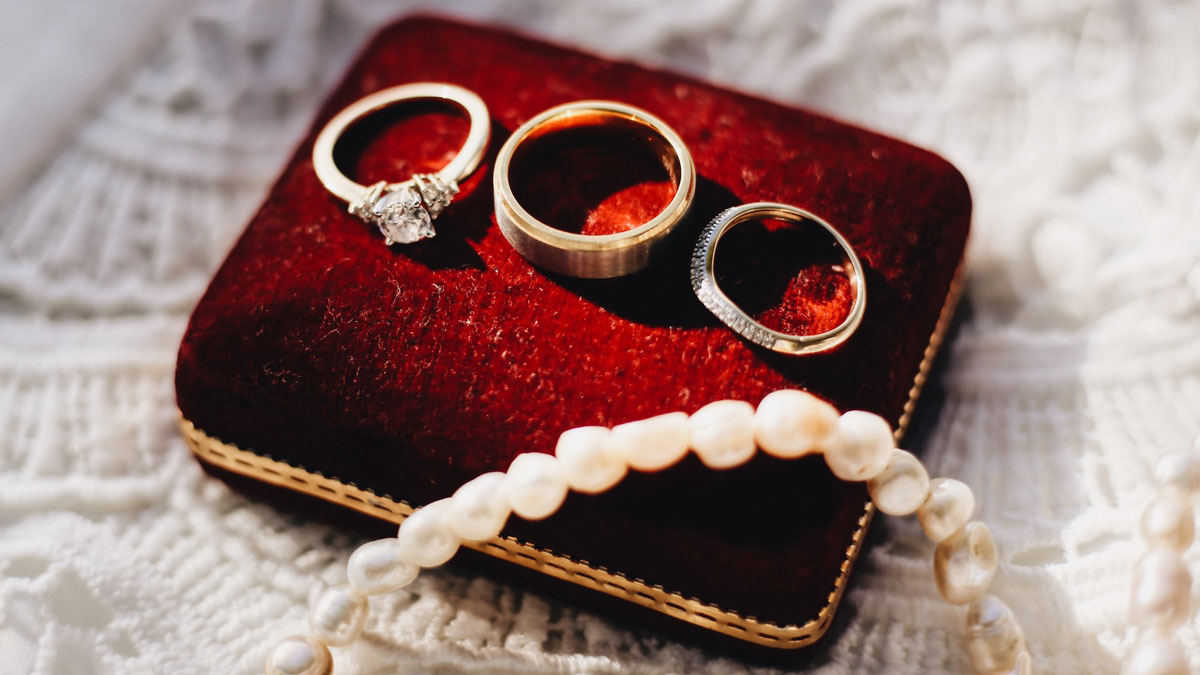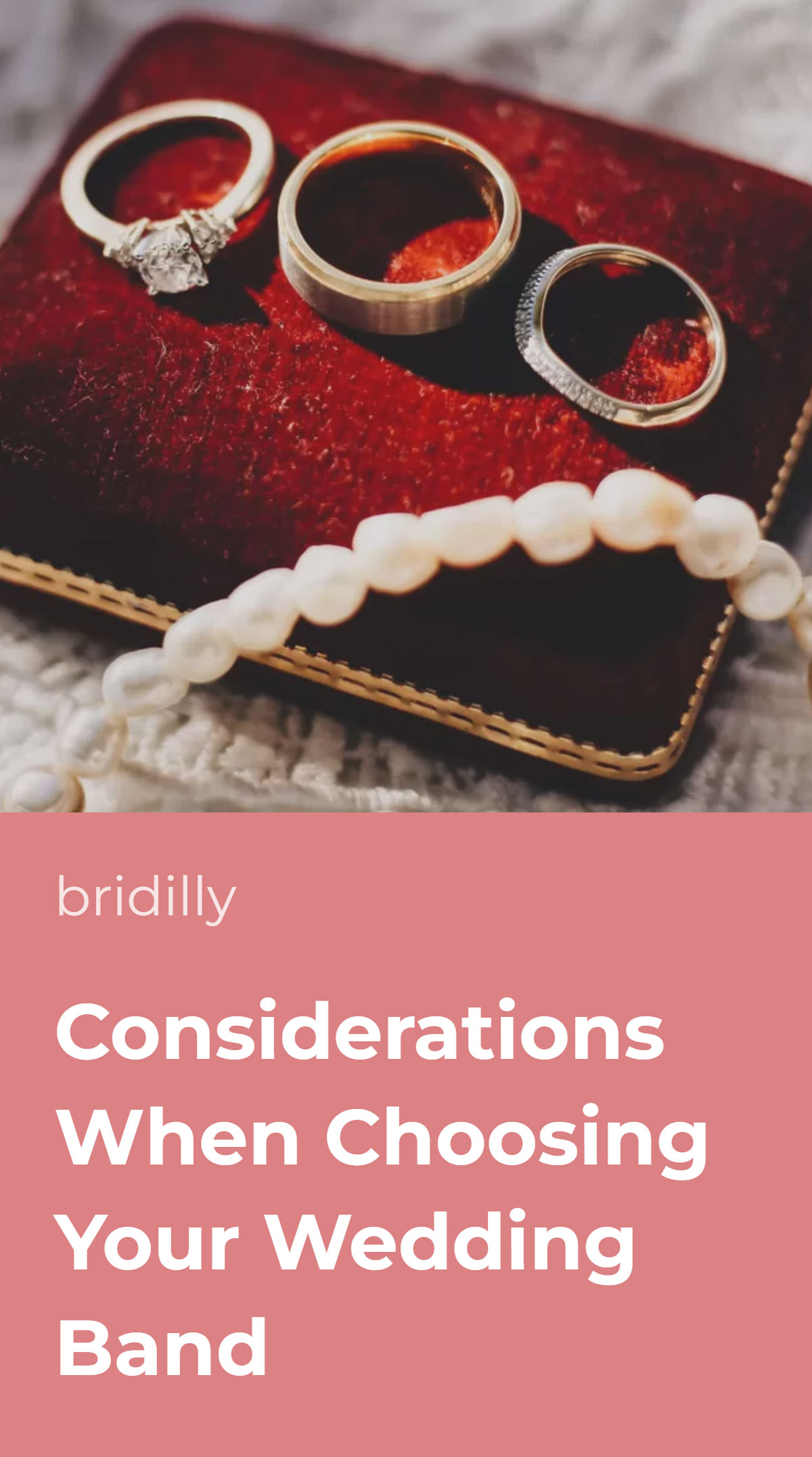At some point in the wedding planning, every bride and groom wonders how to choose a wedding band.
Your wedding band should fit your lifestyle, fashion preferences, personality, and budget. Women often match their wedding band to the engagement ring.
The metal, gemstones, and design play a significant role in the wedding ring’s comfort, look, and durability.
Picking a piece of jewelry that you’ll wear your entire life can be intimidating. Remember that the choice is only yours, and you can replace the rings after some years if you wish to.
Most importantly, do your research and discuss your budget and references with your partner before heading wedding band shopping.
Table of Contents [show]
Metal
Metal is the first point you should decide on when choosing a wedding band. Gold is a traditional wedding ring metal. However, not all gold rings are the same.
One may think that the higher karat, the better, but 24-karat gold is very soft and can be easily scratched or bent. Look for 18-karat or 14-karat gold rings for high gold content and durability.
Yellow, white, and rose gold also differ. White gold is more robust than yellow gold because it contains platinum, silver, manganese, or palladium alloys. It must be rhodium-plated every year to maintain the bright color.
Rose gold is the most durable of the three, featuring high copper content. Consider the durability and your style preferences to pick the right gold type.
For instance, if you typically wear silver or white gold jewelry, choose a white gold ring.
Another common wedding band material is platinum. It’s the rarest precious metal known for its durability. Platinum rings maintain bright color without replating and don’t get scratched.
However, a wedding band doesn’t necessarily have to be made from precious metals like gold or platinum. Sterling silver is a popular choice among couples on a budget.
Although it isn’t as durable as gold or platinum, silver can look stunning with regular polishing and cleaning. Like gold, pure silver is too soft for jewelry and is typically mixed with copper or other metals.
Titanium is a modern alternative to precious metals initially used in industrial applications. It’s a highly durable and lightweight metal that doesn’t need maintenance and has a unique look. The only downside of titanium rings is that they can’t be resized.
All these points also apply to tungsten – it’s modern, tarnish and scratch-resistant, lightweight, and four times stronger than titanium. However, tungsten rings can’t be resized, so choosing the right size is vital.
Other alternative wedding band materials to consider are damask steel, palladium, meteorite, ceramic, and cobalt.
Style
Wedding bands come in many styles, and defining your favorites can significantly reduce the time spent choosing your ring in a jewelry store. Metal bands without gemstones are a traditional, minimalist choice.
Metal bans don’t have to be plain – they can feature engravings, facets, or other design intrications. This style is perfect for active people who plan to wear their wedding band constantly without worrying about damaging the gemstones.
Eternity wedding rings are popular among women, featuring an array of identically sized gemstones. Full eternity rings are fully covered in gems, whereas half eternity rings only have gemstones on half of the band.
Eternity rings have exquisite sparkle, but they are challenging to resize. Furthermore, eternity rings with a prong setting can catch clothes and scratch skin. Channel setting, where the stones are set between two metal channels, is more practical.
Infinity wedding bands feature two metal bands interconnecting in an infinity symbol. They can be plain or have gemstones around the entire circumference. Like eternity bands, they are typically tricky to resize but carry beautiful symbolism.
Five-stone wedding rings are similar to half-eternity bands, but the gemstones are more prominent. Another popular type is three-stone rings, a timeless classic often featuring a larger center gemstone and smaller side stones.
Twisted, curved, vintage, and solitaire are other wedding ring types to consider. Curved bands often come in ring sets to contour the engagement ring, while vintage rings typically have elaborate designs. Solitaire style is more common in engagement rings.
Gemstones
Unless you prefer plain metal bands, gemstones are a crucial point to consider when choosing your ring. Diamonds are a traditional choice, known as the most durable precious stones representing eternal love.
The biggest downside of diamonds is the price. Most people have to compromise the cut, clarity, color, or carats. Alternatively, you may opt for a lab-grown diamond or moissanite, the closest alternative to diamonds.
Amethysts, sapphires, rubies, and emeralds are the most popular colored alternatives to diamonds. They aren’t quite as hard but still pretty durable and come at a fraction of the diamond’s price.
Tsavorite, morganite, garnet, topaz, peridot, aquamarine, tanzanite, citrine, and tourmaline are less common wedding ring gemstones that are nearly as hard as sapphires and rubies.
Semi-precious gemstones like turquoise, pearl, opal, or onyx can also be used in wedding rings, giving them a personal touch. However, such gems are relatively soft and can be easily damaged if you wear the ring constantly.
If you fancy a pop of color but want to stick with the diamond wedding ring tradition, consider colored diamonds or mix clear diamonds with other gemstones. Note that colored diamonds are very rare and expensive.
When choosing your wedding ring gemstone, consider the look, durability, price, and symbolism. Diamonds are always a great choice, but you don’t have to go for a diamond if you want something more personal.
Comfort
A wedding band is a piece of jewelry many people wear daily, so comfort is an important consideration. A wedding band’s comfort depends on its design and fit.
Plain metal bands are the most comfortable because they don’t catch clothes, don’t scratch the skin, and don’t require extensive maintenance. If you find plain bands too unoriginal, consider designs with engravings.
Alternatively, consider channel-set eternity bands. They aren’t as sparkly as eternity bands with a prong setting, but it’s an excellent compromise for women dreaming of a gemstone wedding ring but valuing comfort.
Of course, you are free to choose any wedding ring design if you will only wear it occasionally. Many people nowadays don’t wear their bands every day, and there’s nothing wrong with that if you both don’t mind.
Most importantly, the ring shouldn’t be too tight or too loose. In the former case, it will make your finger swell and be hard to take off. In the latter case, it may fall off your finger. Consider visiting a jeweler to find the right ring size.
Your Lifestyle
Your ring should fit your personality and lifestyle. Think about your profession, hobbies, fashion preferences, and attitude to luxurious items. Do you spend your day at the desk, or do you admire extreme sports?
Are you a humble person or outgoing and extravagant? What’s your clothing style? Answers to these questions will help you find a ring that complements your lifestyle.
For example, plain tungsten wedding bands are ideal for active couples with an alternative style who don’t care about luxury. On the other hand, an exquisite diamond eternity ring will fit brides who value tradition and fancy sparkle.
Colored semi-precious gemstone rings with intricate designs are great for people who work at the desk and won’t damage the ring, including teachers, copywriters, bank workers, and designers.
After all, some people aren’t allowed to wear the ring at work – mechanics, carpenters, nurses, electricians, and cooks, to name a few. In this case, an inexpensive, plain metal band is the best choice.
Your Engagement Ring
The engagement ring design is an essential consideration for women planning to wear both their rings. Match your wedding band’s width, metal, and gemstones to the engagement ring to ensure they go well together.
As a rule of thumb, choose rings from the same material and of the same width. For example, if you have a white gold solitaire diamond ring, you may choose a plain white gold wedding band and or diamond eternity ring.
Remember not to go overboard. Sometimes, rings with different metals, widths, or gemstones look stylish together, but only if one element differs and the rest are similar.
A set of a white gold sapphire solitaire engagement ring and a white gold diamond eternity band is an example of good matching, whereas the same engagement ring with a yellow gold eternity band may be too much.
If you’re still unsure how to pick a wedding band to match the engagement ring, draw inspiration online or consider ring sets. You may find a wedding band that contours your engagement ring stone.
Many couples have different style preferences, so you may wonder – do wedding bands have to match? No, your wedding bands can differ, although matching bands are a symbolic choice.
Price
Set your wedding band budget and stick with it. There’s no right or wrong when it comes to wedding ring price – choose your budget based on your income, preferred design, and attitude to spending.
The average wedding ring price is $1,100 for women and $550 for men, but you’re free to spend significantly less or more than that.
If you can’t afford gold rings, get cheaper silver or tungsten alternatives instead of going into debt. Your wedding ring budget is no one’s business.

















No Comments Add one
Leave a Comment